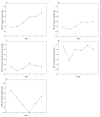Variability in Motor Threshold during Transcranial Magnetic Stimulation Treatment for Depression: Neurophysiological Implications
- PMID: 37759847
- PMCID: PMC10526536
- DOI: 10.3390/brainsci13091246
Variability in Motor Threshold during Transcranial Magnetic Stimulation Treatment for Depression: Neurophysiological Implications
Abstract
The measurement of the motor threshold (MT) is an important element in determining stimulation intensity during Transcranial Magnetic Stimulation treatment (rTMS). The current recommendations propose its realization at least once a week. The variability in this motor threshold is an important factor to consider as it could translate certain neurophysiological specificities. We conducted a retrospective naturalistic study on data from 30 patients treated for treatment-resistant depression in an rTMS-specialized center. For each patient, weekly motor-evoked potential (MEP) was performed and several clinical elements were collected as part of our clinical interviews. Regarding response to treatment (Patient Health Questionnaire-9 (PHQ-9) before and after treatment), there was a mean difference of -8.88 (-21 to 0) in PHQ9 in the Theta Burst group, of -9.00 (-18 to -1) in the High-Frequency (10 Hz) group, and of -4.66 (-10 to +2) in the Low-Frequency (1 Hz) group. The mean improvement in depressive symptoms was 47% (p < 0.001, effect-size: 1.60). The motor threshold changed over the course of the treatment, with a minimum individual range of 1 point and a maximum of 19 points (total subset), and a greater concentration in the remission group (4 to 10) than in the other groups (3 to 10 in the response group, 1 to 8 in the partial response group, 3 to 19 in the stagnation group). We also note that the difference between MT at week 1 and week 6 was statistically significant only in the remission group, with a different evolutionary profile showing an upward trend in MT. Our findings suggest a potential predictive value of MT changes during treatment, particularly an increase in MT in patients who achieve remission and a distinct "break" in MT around the 4th week, which could predict nonresponse.
Keywords: motor threshold; transcranial magnetic stimulation; treatment-resistant depression.
Conflict of interest statement
A.B., S.M., L.L., B.C. and F.F. declare no conflict of interest related to the subject of this article. B.M. is an SYNEIKA (neuronavigation system applied to TMS) shareholder and has served as a consultant for Brainsway.
Figures



Similar articles
-
Day-to-day variability in motor threshold during rTMS treatment for depression: Clinical implications.Brain Stimul. 2021 Sep-Oct;14(5):1118-1125. doi: 10.1016/j.brs.2021.07.013. Epub 2021 Jul 27. Brain Stimul. 2021. PMID: 34329797
-
Corticomotor plasticity as a predictor of response to high frequency transcranial magnetic stimulation treatment for major depressive disorder.J Affect Disord. 2022 Apr 15;303:114-122. doi: 10.1016/j.jad.2022.02.005. Epub 2022 Feb 6. J Affect Disord. 2022. PMID: 35139416
-
Efficacy of intermittent Theta Burst Stimulation (iTBS) and 10-Hz high-frequency repetitive transcranial magnetic stimulation (rTMS) in treatment-resistant unipolar depression: study protocol for a randomised controlled trial.Trials. 2017 Jan 13;18(1):17. doi: 10.1186/s13063-016-1764-8. Trials. 2017. PMID: 28086851 Free PMC article. Clinical Trial.
-
Novel Augmentation Strategies in Major Depression.Dan Med J. 2017 Apr;64(4):B5338. Dan Med J. 2017. PMID: 28385173 Review.
-
Repetitive Transcranial Magnetic Stimulation for People With Treatment-Resistant Depression: A Health Technology Assessment.Ont Health Technol Assess Ser. 2021 May 6;21(4):1-232. eCollection 2021. Ont Health Technol Assess Ser. 2021. PMID: 34055112 Free PMC article.
Cited by
-
Neuronavigated Right Orbitofrontal 20 Hz Theta Burst Transcranial Magnetic Stimulation Augmentation for Obsessive-Compulsive Disorder with Comorbid Depression and Anxiety Disorders: An Open-Label Study.Brain Sci. 2024 May 10;14(5):483. doi: 10.3390/brainsci14050483. Brain Sci. 2024. PMID: 38790461 Free PMC article.
-
Single-pulse transcranial magnetic stimulation of the dorsolateral prefrontal cortex does not directly affect muscle sympathetic nerve activity in humans.Cereb Cortex. 2024 Dec 3;34(12):bhae484. doi: 10.1093/cercor/bhae484. Cereb Cortex. 2024. PMID: 39710610 Free PMC article.
References
-
- World Health Organization . Depression and Other Common Mental Disorders: Global Health Estimates. World Health Organization; Geneva, Switzerland: 2017. Report No.: WHO/MSD/MER/2017.2.
LinkOut - more resources
Full Text Sources

